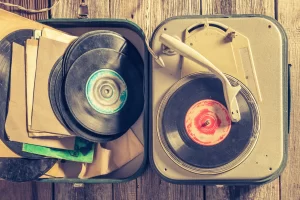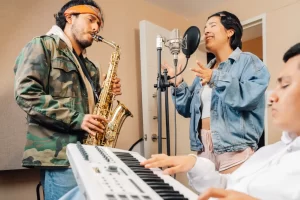Sampling, a technique as revolutionary as it is contentious, has been a cornerstone in the evolution of modern music. It’s an art form that involves reusing portions of pre-existing recordings—be it a drum break, a melodic riff, or a vocal snippet—to create new musical compositions. This blog post delves into “The Art of Sampling: Creativity in Reusing Music,” exploring how this technique has shaped and transformed various music genres.
From the early days of hip-hop, where DJs and producers unearthed forgotten grooves from dusty vinyl records, to the contemporary landscape of electronic and pop music, sampling has been a tool for innovation and expression. It’s a practice that sits at the intersection of creativity, technology, and legality, often sparking debates around originality and copyright.
Sampling has given artists a palette to repurpose and reinterpret sounds, creating music that blurs the lines between past and present, tradition and modernity. But it’s not without controversy. The act of sampling raises important questions about artistic integrity and the legal implications of repurposing someone else’s work.
As we dive into the world of sampling, we’ll explore its history, techniques, and the influential artists who have mastered this craft. We’ll also tackle the ethical and legal considerations, offering a comprehensive view of how sampling continues to redefine the musical landscape. Join us as we unravel the complexities and celebrate the creativity of sampling in music production.
The Basics of Sampling
Sampling, in its essence, is the act of taking a portion of one sound recording and reusing it in a different song or piece of music. This segment, known as a sample, can be a melody, a rhythm, a speech snippet, or even ambient sounds. The beauty of sampling lies in its ability to breathe new life into these sounds, often transforming them into something entirely distinct from their original context.
There are several types of samples commonly used in music production. Drum breaks, for instance, are popular in genres like hip-hop and breakbeat, where the rhythmic portion of a song is isolated and looped. Melodic samples involve taking a tune or a part of a melody from an existing track, while vocal phrases can range from a full chorus to a single spoken word. Some artists even sample non-musical sounds, like nature noises or cityscapes, to add unique textures to their music.
However, sampling isn’t as simple as just lifting a piece of another song; it’s governed by complex copyright laws. The legality of using a sample depends on getting appropriate clearance from the original copyright holders, which often involves licensing agreements and sometimes financial compensation. Failure to do so can lead to legal disputes and hefty fines, making copyright considerations a crucial aspect of the sampling process.
Sampling is a foundational technique in modern music production, offering artists a way to repurpose existing sounds into new creative expressions. Its versatility and the vast range of sounds available for sampling have made it a staple in music creation, though it requires careful navigation of legal boundaries.
Sampling in Music History
The history of sampling in music is a rich tapestry that reflects the evolution of technology and artistic expression. Its roots can be traced back to the late 1960s and early 1970s, but it was the advent of affordable sampling technology in the 1980s that truly revolutionized its use. Pioneering artists in hip-hop, like Grandmaster Flash and the Sugarhill Gang, began using samples to create complex rhythm tracks and hooks, crafting a new musical language from the fragments of existing records.
Sampling soon spread to other genres, becoming a fundamental element in the development of electronic music. Artists and DJs in the burgeoning house and techno scenes in cities like Chicago and Detroit used samplers to construct new sounds from old records, blending soul, funk, and disco into their tracks. This period marked a significant shift, as sampling technology allowed for more creative manipulation of sounds, enabling producers to slice, dice, and transform samples into unrecognizable forms.
The impact of sampling extends beyond genre boundaries. It became a tool for cultural commentary and artistic expression, with artists using samples to pay homage to their influences, or to repurpose and redefine mainstream media sounds for subversive purposes. Sampling also democratized music production, allowing anyone with a sampler and a stack of records to become a producer.
However, the rise of sampling also brought legal challenges, with high-profile lawsuits shaping the industry’s approach to copyright and sampling clearance. Despite these challenges, sampling remains a cornerstone of modern music production, influencing artists across the spectrum and continually evolving with advances in technology.
The Creative Process of Sampling
The creative process of sampling is an intricate and imaginative journey that transforms existing sounds into a new musical tapestry. This process, at its core, involves a keen ear for potential and a vision for how disparate elements can come together to create something entirely new and original.
Finding and Choosing Samples
The first step in the sampling process is discovering sounds that resonate with the producer’s creative intent. This often involves extensive listening to a wide range of music, including old records, obscure tracks, and diverse genres, to find those unique segments that spark inspiration. Producers look for elements that not only stand out – like a catchy riff, a compelling drum break, or an emotive vocal line – but also those that can be creatively manipulated to fit into a new context.
Manipulating Samples
Once a sample is chosen, the next step is to manipulate it to fit into the new composition. This involves a variety of techniques. ‘Chopping’ breaks the sample into smaller parts or loops, allowing producers to rearrange and repeat certain sections. ‘Pitch shifting’ alters the sample’s key and tempo, making it harmonize with the new track. ‘Layering’ involves combining multiple samples or adding additional instrumentation to create a richer sound. The manipulation process is limited only by the producer’s imagination and technical skills, as they mold the sample to serve their artistic vision.
Integrating Samples into New Compositions
The final step is seamlessly integrating the manipulated sample into a new composition. This requires a careful balancing act – ensuring the sample complements the other elements of the track without overpowering them. The producer must consider how the sample interacts with the rhythm, melody, and overall structure of the new piece. It’s a process of trial and error, tweaking the sample and its placement until it sits just right within the track.
The creative process of sampling is a testament to the producer’s skill in both selecting and transforming existing sounds. It’s a form of musical alchemy that gives old sounds a new lease on life, often introducing them to entirely new audiences. This process is central to the identity of many genres and continues to be a driving force in the evolution of contemporary music.
Ethical and Legal Aspects
Navigating the ethical and legal aspects of sampling is a critical component of responsible music production. Sampling, as a creative process, allows artists to weave existing sounds into new compositions, but this practice also intersects with complex issues of copyright and artistic integrity. Understanding and adhering to these considerations is essential for artists who wish to employ sampling in their work.
Legally, sampling is governed by copyright laws, which protect the original creators’ rights over their recorded work. When an artist uses a sample, they are essentially utilizing a piece of someone else’s copyrighted material. To do this legally, obtaining permission from the copyright holder is typically required, often involving negotiation and possibly financial compensation. Failure to secure the proper clearance can lead to legal disputes and significant financial ramifications, as exemplified by high-profile cases in the music industry. However, this article is not legal advice.
Ethically, sampling treads a fine line between homage and plagiarism. While it can be an expression of artistic respect and influence, it also raises questions about originality and the potential exploitation of the original artist’s creativity. Ethical sampling practices involve not just adhering to legal requirements but also considering the impact on the integrity and value of the original work.
The landscape of sampling is continually evolving alongside technological advancements and changing cultural attitudes. Modern technology allows for greater manipulation of samples, often making it challenging to identify and attribute original sources. This technological progression calls for a nuanced understanding of both the creative and legal realms of sampling.
The practice of sampling, while offering rich creative opportunities, also demands careful navigation of legal and ethical considerations. Respecting these aspects is crucial, not only for legal compliance but for maintaining artistic integrity and fostering a respectful and collaborative music community. Understanding and responsibly handling these complexities ensures that the art of sampling continues to be a vibrant and legitimate part of music production.
Sampling in Modern Music Production
Sampling has evolved significantly to become a staple in modern music production, deeply embedded in the fabric of various genres. Its role in today’s music scene is a testament to the technological advancements and creative ingenuity that continue to redefine the possibilities of sound.
In contemporary music production, sampling is more than just lifting a piece of an existing track; it’s an art form that involves reshaping, repurposing, and recontextualizing sounds to create something entirely new. Advanced digital tools and software have made sampling more accessible and versatile than ever before. Producers can now manipulate samples with incredible precision, altering pitch, tempo, and timbre to seamlessly integrate them into new compositions. This technological evolution has expanded the creative potential of sampling, enabling producers to craft complex and richly textured soundscapes.
The use of sampling in modern music also reflects a cultural shift. In genres like hip-hop, electronic, and pop, sampling is often used to pay homage to past influences or to bring nostalgic elements into contemporary contexts. It’s a way for artists to connect with their musical heritage, bridging generational gaps and creating a dialogue between different eras of music.
Furthermore, sampling has democratized music production. Independent artists and bedroom producers, equipped with just a laptop and a sampling software, can craft professional-quality music. This accessibility has led to a surge in creativity and experimentation, allowing more voices to be heard and bringing diverse sounds and stories to the forefront of the music industry.
However, the ease of sampling in the digital age also raises questions about originality and the over-reliance on existing material. The challenge for modern producers is to use sampling not as a crutch but as a tool for genuine creativity, adding their unique touch to borrowed sounds.
Sampling in modern music production is a dynamic and ever-evolving practice. It embodies the fusion of technology and creativity, shaping the soundscapes of contemporary music and continually pushing the boundaries of what is possible in audio creation. As it evolves, it challenges artists to innovate and redefine the norms of musical expression.
Tips for Aspiring Producers
For aspiring music producers, mastering the art of sampling is a journey that combines technical skills, creativity, and an understanding of the legal landscape. One of the first steps is to grasp the fundamental aspects of sampling. This includes learning how to identify and extract compelling portions from existing tracks, understanding the basics of digital audio workstations (DAWs), and mastering editing techniques such as chopping, looping, and layering. Beginners can benefit immensely from the wealth of online tutorials and courses available that cover these basics.
Developing a keen ear for potential samples is another crucial skill. This involves actively listening to a diverse range of music and identifying elements that stand out, be it a distinct beat, an appealing melody, or a unique sound effect. Over time, this practice sharpens the ability to discern parts of tracks that can be creatively repurposed.
A clear understanding of the legalities surrounding sampling is vital. Aspiring producers should familiarize themselves with copyright laws and ensure they obtain necessary permissions to use samples. This step is crucial to avoid legal complications and to respect the original creators’ work.
Experimentation is at the heart of creative sampling. Producers should feel encouraged to experiment with different sound textures and manipulation techniques, as this fosters the development of a unique style. Drawing inspiration from established artists is beneficial, but it’s important to use samples as a foundation for personal expression rather than relying on them as the main attraction of a track.
Receiving feedback and collaborating with others can significantly enhance a producer’s skills. Sharing work and receiving constructive criticism provides new perspectives and growth opportunities. Collaboration introduces producers to new techniques and ideas, enriching their approach to music creation.
Finally, organization is key, especially when building a sample library. A well-organized collection not only streamlines the creative process but also helps in keeping track of sample sources, which is essential for managing legal clearances.
For aspiring producers, the journey into sampling is a blend of learning, experimentation, and respect for the art form. By honing their technical skills, nurturing their creativity, and navigating the legal aspects, they can unlock a world of possibilities in music production.
To Sum It Up
To sum up, the art of sampling in music production is a multifaceted practice that blends creativity, technical skill, and legal understanding. It’s a process that has revolutionized music genres and continues to be a vital aspect of contemporary music creation. For aspiring producers, mastering sampling is not just about manipulating sounds but also about respecting the original work’s integrity and navigating the complexities of copyright laws.
The journey begins with a solid grasp of the basics – understanding what makes a good sample, how to manipulate it, and how to seamlessly integrate it into new compositions. Developing a discerning ear for potential samples is crucial, requiring producers to actively listen to a wide array of music and identify unique elements that can be transformed into something new and exciting.
However, creativity in sampling must be balanced with an understanding of the legal implications. Navigating copyright issues is essential to ensure that the use of samples is both ethical and legal. This awareness not only protects producers from legal repercussions but also respects the original creators’ rights.
In conclusion, sampling offers a world of creative possibilities, allowing producers to connect with and reinterpret music from the past and present. By combining technical prowess, a keen ear for distinctive sounds, and a mindful approach to copyright, aspiring producers can harness the power of sampling to craft innovative and captivating music.




